9.5 Analysis of common areas from the survey
9.5.1 About your travel
We asked residents where they go for a range of activities:
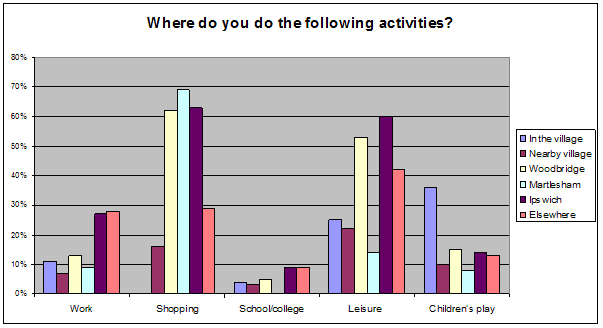
As we see, most people work "elsewhere" or in Ipswich. 22% work in either Woodbridge or Martlesham combined. Ipswich is also the most popular place for leisure activities, with Woodbridge a close second. Over 60% of the residents shop in Ipswich, Woodbridge and Martlesham. However, most children's play takes place in the local village.
We found that 183 residents use their car to get to work every day, with a further 66 using it once a week or more. In contrast, only 8 use the bus and 13 cycle. However, 35 walk to work and 55 work from home.
The car is also the most common way of shopping, with 446 using it once a week or more. The bus is used by 29 people, 5 cycle and 14 walk.
Not surprisingly, the car also dominates travel to leisure activities, with 434 people using it once a week or more. The bus is used for leisure travel once a week or more by 17 people, with 31 cycling and 116 walking. The car remains the dominant form of travel for getting to school or college.
We also asked the young residents where they go for their activities:
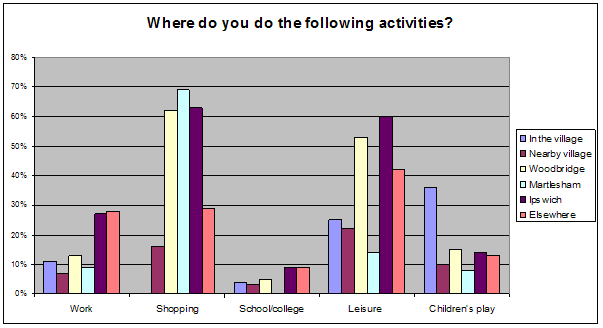
As we see, Ipswich is by far the most popular place young residents go for shopping and leisure activities, with Woodbridge the next most common.
We found that 37 young residents use a car to get to school every day, with a further 26 using a bus. 3 said that they walk every day and only 1 uses a bicycle.
This pattern of travel is repeated for all the other activities that they do, with a car being by far the most common way of getting around, followed by the bus and then by the other forms of transport. See Action 20 for an action on buses.
9.5.2 Roads and Traffic
Residents were asked 23 general questions about traffic and young residents were asked 14. The detail of their answers is given in the appendices, but the key points arising are that 56% of the residents "Strongly Agreed" that traffic goes too fast through their village. Another 32% agreed with the statement. More people in Great Bealings were concerned with traffic speeds (70% strongly agreed) than Little Bealings (58%) or Playford (37%). 55% also "Strongly Agreed" that too much traffic uses the roads through their village as a shortcut at rush hour. Once again, this was most strongly felt in Great Bealings (69%) as opposed to Little Bealings (59%) and Playford (33%).
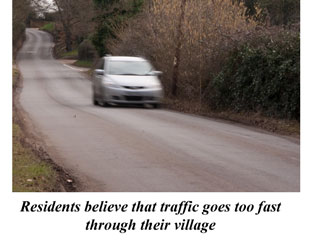 The
young residents agree that traffic goes too fast through their villages,
although to a lesser extent, with only 47% of young residents strongly
agreeing with this sentiment. They felt strongly that speed limits should
be more strictly enforced (42% strongly agreed), that "Too much traffic
uses the roads through my village as a shortcut at rush hour" (37%
strongly agree) and that there's too much traffic for safe cycling (36%
strongly agree). There was little support for methods of enforcing speed
limits such as speed bumps, flashing signs or speed guns (a quote from
one comment "Please don't give villagers speed guns, there are some
fools in this village")
The
young residents agree that traffic goes too fast through their villages,
although to a lesser extent, with only 47% of young residents strongly
agreeing with this sentiment. They felt strongly that speed limits should
be more strictly enforced (42% strongly agreed), that "Too much traffic
uses the roads through my village as a shortcut at rush hour" (37%
strongly agree) and that there's too much traffic for safe cycling (36%
strongly agree). There was little support for methods of enforcing speed
limits such as speed bumps, flashing signs or speed guns (a quote from
one comment "Please don't give villagers speed guns, there are some
fools in this village")
Bealings residents similarly felt that there was too much traffic for safe walking or cycling and that speed limits should be more strictly enforced. Other means of slowing traffic (speed bumps, pinch points) were not supported and the idea that the parishes should buy a speed gun to be used by villagers to enforce speed limits met with general disagreement. The idea of using flashing "slow down" signs had a little agreement, but the most popular potential traffic management measures were to implement a 20 mph limit by Bealings School and to raise the speed limit on the A1214 in Kesgrave. The 20 mph limit by the school also drew strong support from comments made. A number of residents made adverse comment about the give-way system around Clematis Cottage, Playford.
Residents also agreed with the statements "Roadside verges are not mown often enough", "Road edges and verges are excessively worn away" and "Road surfaces should be kept in better repair". Comments relating to the need to maintain verges and hedges better were also very common.
Action 17 Improve knowledge of road problem reporting system; see Action 4 above.
Residents were asked whether they thought specific roads should have 30 mph limits imposed on them or extended. Not surprisingly, they were in favour of extending/introducing all those suggested. The one with the highest level of approval was the limit on Boot Street/Hall Farm Road, Great Bealings. Comments also suggested a weight restriction on the Bealings bridge or on Boot Street.
Action 18 Investigate speed in Boot Street, the use of a 20mph speed limit near the school and whether the 30 mph limit can be extended on Hall Farm Road, Great Bealings.
The suggestion that visibility/sight lines at junctions/cross roads need improving met with widespread support, with 78% of residents agreeing that the crossroads of Martlesham Rd/Playford Rd/Hall Road needs improvement. A chart showing the percentage of people who agreed with the need for improved visibility at local junctions is shown below, analysed by village.
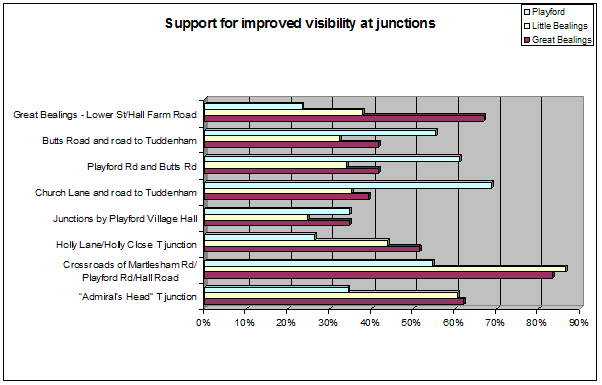
The cross roads at Martlesham Road was also mentioned in comments as being particularly dangerous.
Action 19 Little Bealings/Great Bealings: work with SCC/BT to improve Hall Road junction. Playford: work with SCC to improve Church Lane/Bealings Road junction.
The speed of traffic is a problem expressed by nearly every stakeholder. The Police are also concerned about this problem and are exploring various strategies. There were comments from stakeholders about large buses with very few passengers and lorries on roads unsuitable for HGVs but directed there by SatNav. There were reports of damage to verges caused by large vehicles - not just by farm vehicles - builders, waste collection and large delivery vans are equally culpable. The Highways Department is exploring ways of improving the flow of traffic along the A1214.
Stakeholders also say that there are continuing problems with maintenance of verges and hedges and bordering trees. The latter are the responsibility of individual land owners. Workers from the Probation Service (Unpaid Work - Community Payback) were reported to provide a good service in Playford.
9.5.3 Public Transport
Residents were asked if they would regularly catch a train to/from Bealings Station (which would require re-opening) and 46% either agreed or strongly agreed that they would. Re-opening the station would clearly be expensive and cause disruption to the businesses there and so the steering group believed that the support was not sufficiently overwhelming to make this an immediate priority.
There was strong support for the statement "Bus timetables should be better publicised" with 74% of residents agreeing and 80% of the young residents. There was also support for the view that buses are too large. Residents and young residents also said they would use buses more if they were more frequent.
Action 20 Explore the reliability and timing of buses - especially for young people and local employees - and size of buses with bus companies.
Whilst support for a car-sharing scheme was low in percentage terms (only 11% said they would use one), nevertheless this comes to 48 people - enough to make a scheme potentially viable.
Action 21 Work with interested residents to set up a car sharing scheme.
A couple of employers had problems with recruitment due to the rural nature of the parishes and limited bus services. This was particularly difficult for the pub, as there is no bus service late in the evening. Mallard House employers expressed concern over the lack of buses early in the morning and at the end of the working day. There is some interest in the railway station at Little Bealings being re-instated with a suggestion that one of the units at Mallard House could be transformed into a shop or tea room to serve the villages.
Comments from residents mainly dealt with the need for more buses, especially at the start and end of the day, the need for buses to be smaller and the difficulty of finding timetables.
9.5.4 Schools
When asked about local school provision, residents expressed the strongest views about giving priority at local schools to local children - indeed, for both primary and secondary schools, only 1% disagreed that this should be the policy, with 50% strongly agreeing. Young residents were also strongly in favour of giving priority at local schools to local children with less than 10% disagreeing that this should be the policy for both primary and secondary schools. Comments on the surveys also supported this view.
Action 22 Advise MP and SCC of the desire to give priority at local schools to local children.
There was also strong support for reducing the use of cars to take children to school and improving the car parking near Bealings School. 82% of residents agreed that children should be encouraged to walk/cycle to and from school rather than travel by car, whilst 76% agreed that a cycle path should be developed from Playford to Bealings School. 76% wanted a safe parking area for parents with children at the school and 82% agreed that there should be a safe walking route from the parking area to the school. Comments about the need for improved parking and better footpaths/cycleways were frequent, together with views that it is not safe for children to walk to school at present.
The young residents also gave strong support for reducing the use of cars to take children to school and improving the car parking near Bealings School. Their strongest support was reserved for the statement "Free school buses to all schools should be available".
Action 23 Work with School, SCC and others to address issues of concern over children's travel to Bealings School.
Action 24 Advise MP and SCC of the strength of support for free school buses.
Stakeholders were concerned that there is no public transport for children at the school and that the "tactless" behaviour of some parents has led to permission to park in the pub car-park being withdrawn. Many stakeholders felt that parking around the school is chaotic and dangerous. It was reported that a new cycle path is being organised from Playford to the school. Suffolk County Council has a Travel Plan where they have looked at alternative cycle paths, footpaths etc. The Head Teacher believes that the school and Parish Council should work together to put pressure on SCC to improve road-signs, slow down traffic, install speed cameras etc. The back door to the school is now open, providing access from the footpath through the churchyard.

The Head Teacher and pupils are very interested in allotments/growing their own food/sharing produce/saving energy/green issues/recycling/solar panels. The children can also monitor wildlife or help with litter-picking etc.
It was suggested that one of the school buildings could be used for a drop-in cafe during the daytime (but not lunchtime), run by volunteers. This could provide some sort of "village centre".
There is a vacancy for a Community Governor at the moment and the school is always looking for various volunteers. It was suggested that the Benefice Magazine could be used for publicising any vacancies.
The school Christmas production is very popular - open to everyone not just parents - but there are sometimes problems with booking the village hall for this event.
9.5.5 Use of Footpaths/bridleways/cycle paths
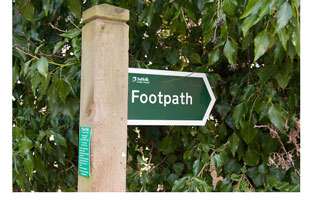 The
survey showed that villagers use the footpaths around the villages to
a considerable extent. 60% said that they regularly walk on public footpaths
and a further 44% said they also walk their dogs on footpaths. 14% cycle
off road and 5% ride a horse. 69% of respondents thought that footpaths
should be better maintained and 60% believed that it's necessary to improve
the ease of use of new gates for disabled users.
The
survey showed that villagers use the footpaths around the villages to
a considerable extent. 60% said that they regularly walk on public footpaths
and a further 44% said they also walk their dogs on footpaths. 14% cycle
off road and 5% ride a horse. 69% of respondents thought that footpaths
should be better maintained and 60% believed that it's necessary to improve
the ease of use of new gates for disabled users.
Action 25 Discuss scope for improvements to footpaths and gates with SCC and PCs.
The survey found that young residents frequently use the footpaths around the villages, with 50% saying that they use them regularly. 43% said they walk their dogs on the footpaths and a further 34% cycle off road. Only 1 respondent said they ride a horse off road.
A key issue for Great Bealings residents was the lack of a footpath from Boot Street to Bealings Playing Field, where 78% agreed that one should be provided.
Action 26 Investigate provision of a footpath from Boot Street to Bealings Playing Field with SCC and landowners.
61% of Playford residents agreed that the footpath from Playford to Bealings School should be improved and there was also widespread support for more cycle paths to Bealings School and Kesgrave High, with 70% supporting this requirement. Young residents gave their strongest support to the statement that "There need to be more cycle paths to Bealings School and Kesgrave High", with only 2 answers disagreeing with this.
Action 27 Investigate provision of more cycle paths to Bealings School and Kesgrave High and improvements to footpath from Playford to Bealings School with SCC and landowners.
On the whole, stakeholders felt that footpaths were well maintained. It seems that there is no single defined process for maintenance and reporting of problems on footpaths across all three villages which may create some confusion.
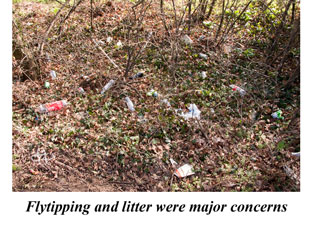 They
said that there is some misuse of footpaths by horses and motorbikes and
dog fouling can be an issue. There is a need to establish responsibility
for hedgerows and trees to ensure they are maintained and not in a dangerous
condition.
They
said that there is some misuse of footpaths by horses and motorbikes and
dog fouling can be an issue. There is a need to establish responsibility
for hedgerows and trees to ensure they are maintained and not in a dangerous
condition.
There is a potential problem with byways - current laws theoretically allow use by inappropriate vehicles (4x4s). This is a national problem but there is particular concern in Playford at the moment.
Written comments from residents emphasised how important footpaths are and the need to maintain them and have them wide enough to be used comfortably. Footpaths and cycle paths were mentioned as being necessary because of the dangers of the local roads.
9.5.6 Natural Environment (e.g. wildlife, trees, rivers, farms)
When asked about the environment, villagers' biggest concerns were with litter on or beside country roads and fly tipping of waste on verges or in fields or in woods, with 89% concerned about general litter and 92% agreeing that fly tipping is a problem.
Action 28 Organise litter pick with SCDC support or with the support of the Probation Service; see Action 4 above for improvements to reporting.
72% were also concerned about the loss of wildlife in the villages.
Action 29 Investigate loss of wildlife in the villages with Suffolk Wildlife Trust and landowners, including the possibility of a Biodiversity Action Plan. Consider investigating the successful work in Parham.
Villagers showed considerable concern about crop spraying taking place without prior notice to local householders, with 62% agreeing that it concerned them. Spraying was also commented on as being a problem for bee keepers and for health of residents.
Action 30 Discuss how to improve notice of spraying with local farmers; see Action 4 above.
The young residents' biggest concerns about the environment were the same as the adults - litter on or beside country roads and fly tipping of waste on verges or in fields or in woods. 70% were concerned about general litter and 78% agreed that fly tipping is a problem. 59% were concerned about the loss of wildlife in the villages. Comments from residents bemoaned the amount of fast food packaging in the verges and the general decline in the maintenance of hedgerows and trees.
9.5.7 Village Halls and Churches
There was a general consensus that more/better notice boards for village events are needed, with 45% agreeing with this. It was seen as a biggest problem by Great Bealings residents. The young residents shared the view of the adults that more/better notice boards for village events are needed, with 64% agreeing with this.
Action 31 Work with PCs to improve notice boards, in particular Great Bealings; see Action 4.
From the responses, it was apparent that most people see the village church as important to them as an historic building (88% agreement) and as a focal point for the community (73%). Over 170 people said that it was important to them for worship. Young residents also agreed with the adults that the village church is most important to them as an historic building (68% agreement) as opposed to for worship (24% agreed).
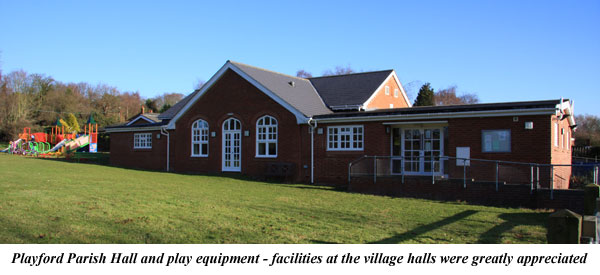
Residents' comments suggested that they would like the services to be more family and child friendly and that they would like to see other events like music in the church. There was also support for the Playford "pub nights".
Stakeholders noted that services rotate around the 3 churches and elderly people can find it difficult to travel to another village. Finance is a worry for day-to-day bills and more volunteers would be appreciated to maintain churchyards etc. Several stakeholders mentioned the increase in community spirit since the current incumbent joined us. It was hoped that greater links with Bealings School could be fostered to encourage participation by younger people.
Workers from the Probation Service help with maintenance at Little Bealings church which is extremely useful and other organisations could also benefit from this facility.
Many stakeholders expressed their great satisfaction with the facilities provided at the village halls and at the new Playing Field. There were a couple of concerns mentioned by individual stakeholders. There was a suggestion that floodlights be installed at the new playing field to get better usage but they would need to be on a timer to protect local residents. Some of the tennis equipment is getting damaged or lost as courts are multi-use and equipment such as tennis nets must be put up and taken down regularly.
The heating in Bealings Village Hall can be inadequate on very cold days. Car parking space is a problem due to parents parking for the school and the poor surface means flooding in bad weather. Finances are always a concern.
9.5.8 Pollution
Residents were asked what sort of things they were disturbed by. Residents of Little Bealings are particularly affected by noise from helicopters, with 51% saying this is a problem for them.
Action 32 Advise SCDC of concern over noise from helicopters.
Apart from that concern, the occupants of our parishes had no real other issues concerning noise, smells or light pollution. Their comments centred mainly on the noise from the aggregate site on the A12 and noise from passing traffic.
Young residents identified very little and expressed no specific concerns.